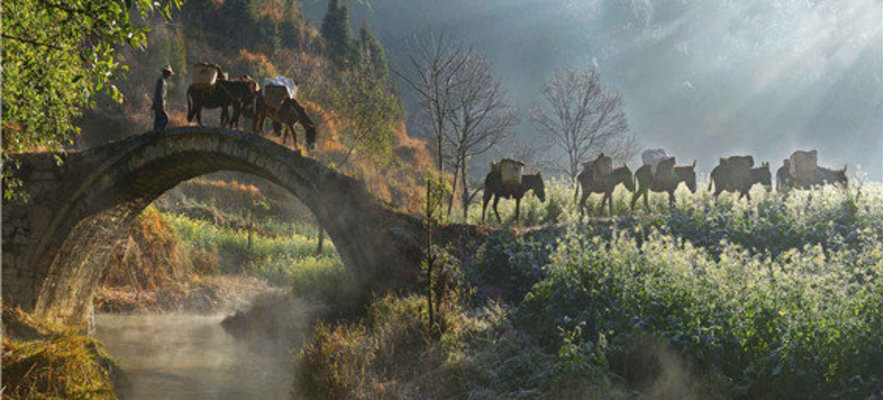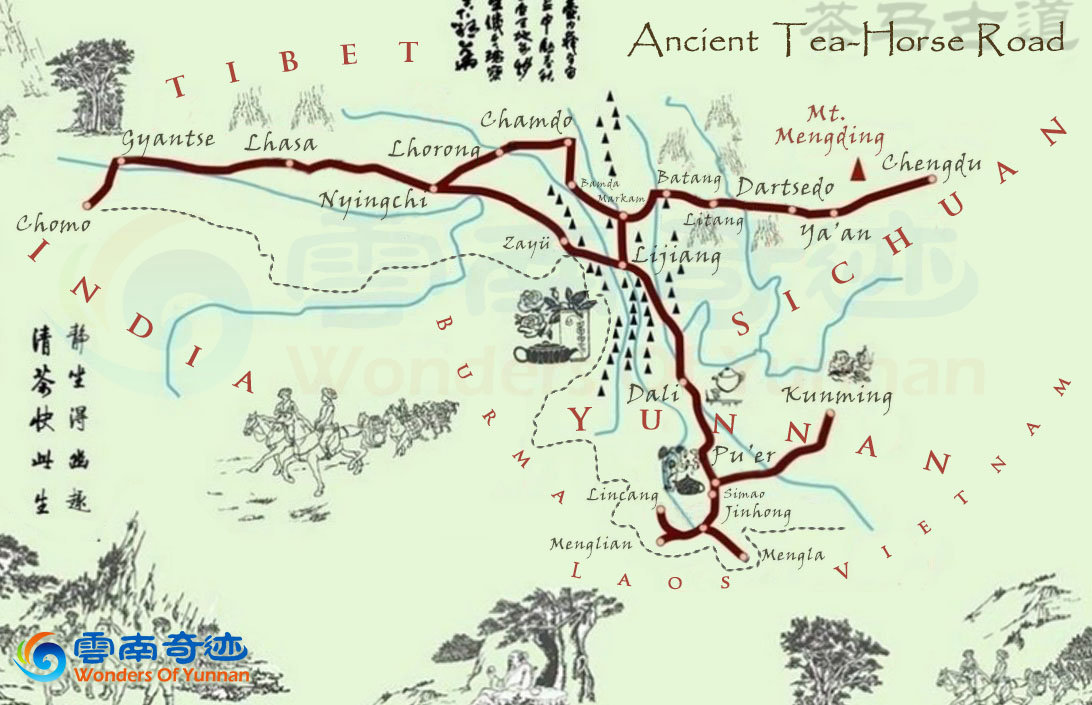
茶马古道是我国历史上内地农业地区和边疆游牧业地区进行茶马贸易所形成的古代交通路线,分青藏线(唐蕃古道)、滇藏线和川藏线,。茶马古道存在于中国西南地区,是以马帮为主要交通工具的民间国际商贸通道。滇藏茶马古道。
大约形成于公元六世纪后期,历经汉、晋、隋、唐、宋、元、明、清,是中国历史上最为著名的西部国际贸易古通道之一。它南起云南茶叶主产区西双版纳易武、普洱市,中间经过今天的大理白族自治州和丽江市、香格里拉进入西藏,直达拉萨。有的还从西藏转口印度、尼泊尔,是古代中国与南亚地区一条重要的贸易通道。
The Tea Horse Road is an ancient trade route that came into being from the tea trade via horses from the tropical areas of southern Yunnan to the snow-covered plateaus of the Himalayas. When we mention the Tea-Horse Road, we are not talking about one road, but a network of separated trails divided into the Qinghai-Tibet route, the Yunnan-Tibet route and the Sichuan-Tibet route. We will take a deeper look into the Yunnan-Tibet Tea Horse Road.
The Yunnan-Tibet Trail can be sourced back to the late sixth century AD, and it has been one of the most famous ancient channels of international trade with the West in Chinese history, surviving through the Han, Jin, Sui, Tang, Song, Yuan, Ming and Qing dynasties. The route starts from Yiwu in Mengla county in Xishuangbanna and Pu'er City, the main tea producing areas in Yunnan, and passes through today's Dali, Lijiang and Shangri-La prefectures, to finally enter Tibet and continue to Lhasa. Some tea also got exported to India and Nepal, which also was a very important trade route between ancient China and the rest of Asia.
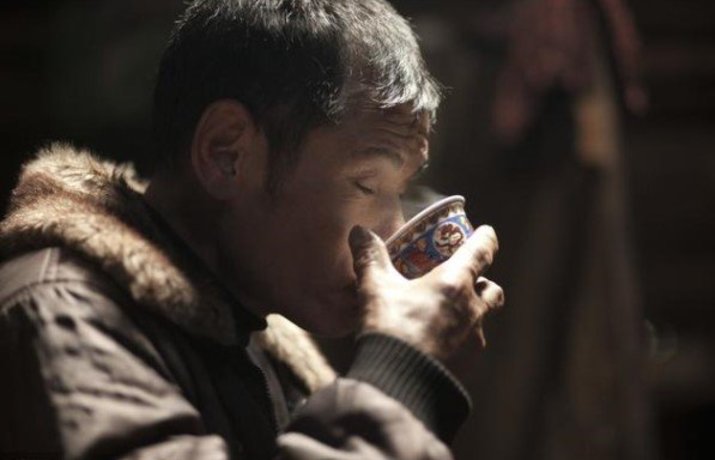
因康藏属高寒地区,海拔都在三四千米以上,糌粑、奶类、酥油、牛羊肉是藏民的主食。在高寒地区,需要摄入含热量高的脂肪,但没有蔬菜,糌粑又燥热,过多的脂肪在人体内不易分解,而茶叶既能够分解脂肪,又防止燥热,故藏民在长期的生活中,创造了喝酥油茶的高原生活习惯,但藏区不产茶。而在内地,民间役使和军队征战都需要大量的骡马,但供不应求,而藏区和川、滇边地则产良马。于是,具有互补性的茶和马的交易即“茶马互市”便应运而生。这样,藏区和川、滇边地出产的骡马、毛皮、药材等和川滇及内地出产的茶叶、布匹、盐和日用器皿等等,在横断山区的高山深谷间南来北往,流动不息,并随着社会经济的发展而日趋繁荣,形成一条延续至今的“茶马古道”。
Because Tibet is a high-altitude alpine region, with an average altitude 4,500m, the Tibetan staple foods consist of Zanba (roasted barley bread), dairy, butter, beef and mutton. In alpine regions, people have a high-calorie and fat diet, with little vegetables because it is hard to grow them. Too much fat is not easy to decompose in the human body, but tea can help break down fat, and not only that, but it is also beneficial in hot and dry weather, so Tibetans created the habit of drinking butter tea. The Tibetan environment, however, is not suited to produce tea. On the other hand, in Mainland China, the imperial army required a large number of horses for their battles against northern invaders. But horses, ponies, mules and donkeys were in short supply in China, while the Tibetans bred many good and sturdy equines well fit for China’s wars. As a result, the "tea-horse trade" came into being. And thus, a continuous trade flow developed between the deep valleys of the Hengduan Mountains; of horses, mules, furs and medicinal materials from Tibet, Sichuan and Yunnan provinces and of tea, cloth, salt and daily utensils from Sichuan, Yunnan and the mainland. With the development of social economy, these ancient trade routes have become increasingly prosperous, forming a "Tea-Horse Road" that continues to this day.
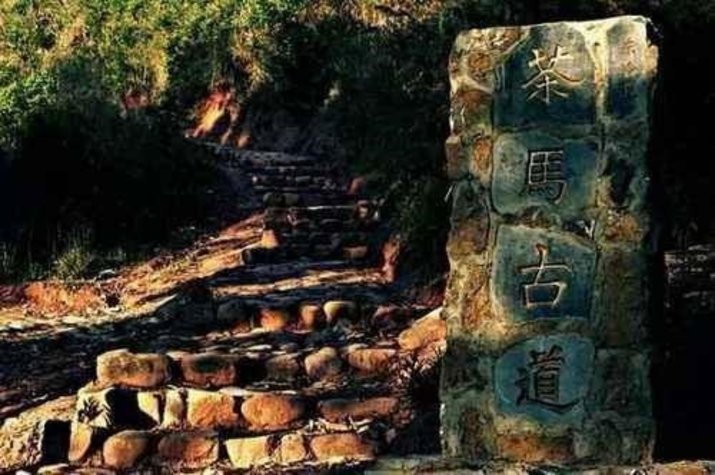
这条小道仅有一尺多宽,据说顺着这条古路可以从维西走到德钦,再从德钦进入西藏,然后到达印度。但当时他们不太相信,这条不起眼的小路能通向遥远的印度。
吐蕃和南诏的军队曾在塔村进行过几次大的战争(794年),这就出现了另外一个疑问:这场历史上著名的战争必然会耗费大量的兵力,那些参战的士兵是怎样到达这里的呢?是不是真有一条神秘的古老通道?
This trail you see here is only a meter or so wide. Imagine walking a trail like this from the tropical forests in the south to the snow-covered Himalayan plateau, and even continuing to India. Many people at that time did not even believe that this insignificant path could lead all the way to distant India. Many even doubted the whole existence of the road.
But there is evidence. The Tubo (ancient Tibet) and Nanzhao (ancient Dali) kingdoms had several major wars at the border of Tibet and Yunnan in the year 794. Here arises the question: these famous wars unavoidably cost a lot of troops, how did the soldiers arrive here? Is this evidence of some mysterious ancient passage or trail?
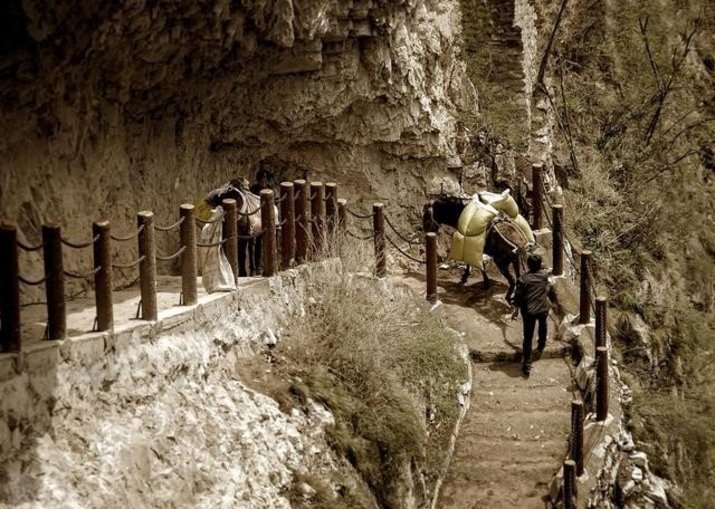
既然说到茶马古道,少不了要提一下行走在古道上的传奇马帮。想当年,那些马帮没有路,在茂密的原始森林中自己开辟路,蚊虫猛蛇,缺医少药,人马饥寒交迫,是许多马帮人再难活着回来的根本原因。川西、滇西北和西藏雪峰高耸,峡谷深深,车辆船只在这里根本派不上用场,货物只能靠骡马、牦牛驮运和人力背负。
When speaking about the ancient tea-horse road, it is impossible not to mention the legendary caravans that travelled the ancient road. In those ancient time, travelling was dangerous and not something the common folk would easily consider. There were no roads, and people had to make their own way through the dense primal forests, facing the dangers within them such as mosquitoes and snakes. Then they would have to pass through the deep canyons and towering, snowy mountains of Western Sichuan, Northwest Yunnan and Tibet. Vehicles and ships are of no use in these regions, and goods can only be carried by mules and horses, yaks and humans. There was no medical care on the way, and hunger and cold were the biggest threats to both the animals and people in the caravans. It was a risky business, and many travellers of the caravans would not make it back to their home town alive.

一个马帮常拥有百匹以上的骡马,有的多达200匹。茶马古道上的马帮,一路风餐露宿,在滇藏、川藏间往返一趟,往往要一年多的时间。至今在茶马古道旧道上,还能见到嵌入石板足有二寸多深的马蹄印痕。
One caravan often consisted of more than a hundred horses, some having as many as two-hundred. It took over one year to cover the round trip. Now, centuries later, the five-centimetre-deep footprints of horseshoes can be seen on the stone slates of ancient trails that have survived the tests of time.
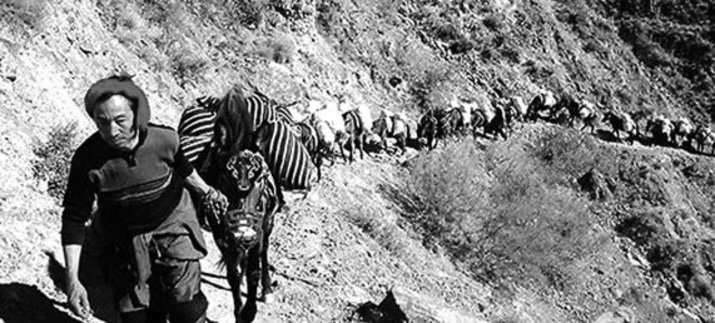
马帮的头目被称为“马锅头”,马锅头是马帮的核心人物,负责处理马帮运货途中的一切事务。每个马锅头大约要管理一百多匹马和二十多个马夫,据说,那时马锅头待遇十分优厚。马夫们也很辛苦,根据个人能力,一个马夫一般得照顾4~12匹马,照顾的马越多,获得的酬劳就越高。相比当时其它的工作,马夫马锅头算是赚钱最多的行业之一,这就是为何有九死一生的艰险,那么多人也热衷做马锅头和马夫。当地人笑称,直到今天,茶马古道一带的马锅头后代还过着相当富裕的生活。
The leader of the caravan was called "Maguotou", meaning literally translated “Horse-pot-head”. The Maguotou was the core figure of the caravan, responsible for handling all the official and unofficial affairs of the caravan. Each Maguotou managed more than a hundred horses and more than twenty horsekeepers. It was said that the Maguotou’s were very well paid for their work. But the horsekeepers’ job was also very though. Depending on their capability, each horsekeeper took care of four to twelve horses, and the more horses he cared for, the higher the reward was. Compared with other work at that time, Maguotou was one of the most profitable jobs. This is why even though it was a dangerous undertaking, many people were keen to become Maguotou or horsekeepers. Even until this day, old people say with a smile that the descendants of the Maguotou’s still live a rather prosperous life.
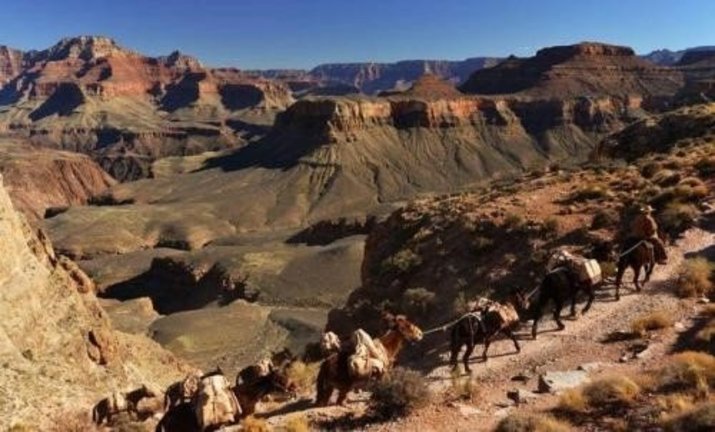
在这条古道上有几十个古驿站,驿站的作用就是使滇茶完成入藏的历程。驿站是古道马帮歇脚、打间、整理抑或分销货物的一个枢纽,束河古镇就是古道上一个著名的古驿站。
There were dozens of ancient trading posts along this ancient road, whose functions were to make sure the tea from Yunnan would complete the process of entering Tibet. The trading posts were a hub for the caravans to rest and arrange or distribute goods. Shuhe is a famous trading post on the ancient Tea-Horse trail that is well preserved until this day.
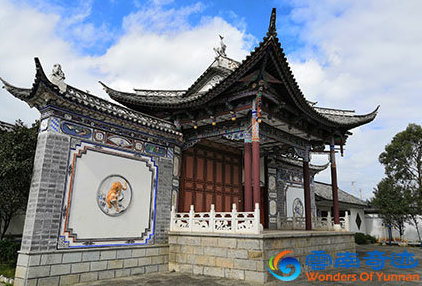
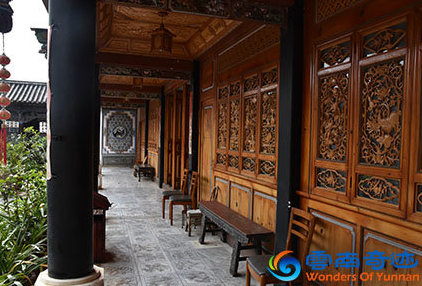
作为茶马古道上的一个重镇和中转的驿站,喜洲,便成为了过往马帮商旅贸易、歇脚、整憩、补给的中心。各色人等的进入,让多元的文化在这里交流汇聚,一拨又一拨的马帮来了又走了,马蹄声声,为这里驮来了经济的繁荣、工商业的发达与生活的富庶。
As a major town on the ancient Tea Horse Road and a transit station, Xizhou also became a central hub for the trade. People gathered here to exchange their goods and share their diverse cultures. Caravans came and went. The sound of horse hooves brought with it great prosperity to the economy, the development of industry and commerce and wealthy lives for the people in the places on the route.

在很早以前,束河的四方街上就有夜市,人们在这里购物、吃饭、游戏,也十分惬意。茶马古道的兴盛也曾带动了束河的繁荣,古镇。
A long time ago, there was a bustling night market on Sifang Street of Shuhe ancient town. People came here for shopping, eating and entertainment. Life was slow and comfortable. The prosperity of the Tea Horse Road led to the prosperity of Shuhe Town.

灿烂的阳光,洁白的云朵,纯净的天空,稀薄的空气,连绵的雪山,安静的湖泊。在这佛教圣地,有繁多的寺庙,虔诚的教徒,走在拉萨的街市,仿佛穿越了时空,来到了唐朝,那一小队风尘仆仆的商队,给这个圣洁的地方染上了喜庆。那一排排有着千年历史的房屋,或许他们才是这个城市的主人。静静地守护着历史。
Bright sunshine, spotless white clouds, a pure and clear blue sky, thin air, unending rolling snow mountains and quiet lakes. In this Buddhist’s holy land, there are many temples and devout believers. Walking the streets of Lhasa feels as if you travelled through time and space, and arrived back in the ancient Tang Dynasty. That small group of dusty caravans brought colour and joy to this holy place. There are rows of houses that are thousands of years old, seemingly the real masters of the city, quietly guarding history.

在《消失的地平线》中,曾这样描述独克宗古城。
「昨夜有梦,遥远且古老。梦见庄严宗祠、虔诚僧侣、质朴村民、梦见千山飞雪间灯火通明的古老村落,梦见远道而来的马帮于此修整,马蹄轻脆,铃铛轻响。」
"I had a dream last night, a distant and ancient dream. A dream of a solemn ancestral temple, devout monks, simple villagers and foggy lights of an ancient village dotted among the mountains and snow. I dreamt of a caravan that came from distant lands to rest and recover here, the horse hooves light and brittle and bells ringing like whispers."
Description of Dukezong old town, from Lost Horizon – James Hilton

人文精神的超越之路。 马帮每次踏上征程,就是一次生与死的体验之旅。茶马古道的艰险超乎寻常,然而沿途的壮丽的自然景观却可激发人的潜在的力量、勇气和忍耐,使人的灵魂的到升华,从而衬托出人生的真意和伟大。
Every time the caravan embarked on a journey, it was a journey of life and death. But it was the magnificent natural landscape along the ancient tea horse road that stimulated people's inner strength, courage and patience, and set off the enlightenment of people's souls, and helped them to understand the true meaning and greatness of life.
Further Reading:
Shaxi, one of the best-preserved post left of the ancient Tea Horse Road
The Shaxi Friday Morning Market is a leftover from the tea trade
Embark on your own 11-day mule trek adventure along the old Tea Horse Trail
- 680 reads
- Like this






